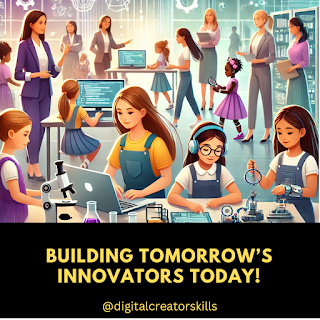The tech industry has long struggled with gender disparities, but fostering a more equitable ecosystem requires strategic efforts in early STEM education for girls, workplace inclusivity, and strong policy advocacy.
These key areas are essential to breaking barriers and ensuring women have equal opportunities to thrive in STEM (Science, Technology, Engineering, and Mathematics) careers.
1. Early STEM Education for Girls
Encouraging girls to pursue STEM from a young age is crucial to closing the gender gap in tech.
Studies show that early exposure to coding, robotics, and scientific exploration helps build confidence and interest in STEM subjects. Schools, educators, and communities must work together to:
- Provide hands-on STEM learning experiences.
- Introduce female role models and mentors in tech fields.
- Challenge stereotypes that discourage girls from pursuing STEM careers.
- Ensure access to resources, scholarships, and educational programs that support girls in STEM.
- Investing in early STEM education not only increases female participation in the industry but also fosters innovation and diversity in tech.
2. Workplace Inclusivity in Tech
Workplace inclusivity is essential for retaining and advancing women in STEM. Companies must adopt policies and cultures that support diversity, equity, and inclusion.
Key strategies include:
Equal pay and leadership opportunities:
Women in STEM often face wage gaps and limited access to leadership roles. Transparent salary structures and leadership development programs can help bridge this gap.
Flexible work arrangements:
Remote work options, flexible hours, and parental leave policies make STEM careers more accessible for women balancing professional and personal responsibilities.
Bias-free hiring and promotion practices:
Companies should implement unbiased recruitment strategies, such as blind hiring and structured interviews, to ensure fair opportunities for women in tech.
A truly inclusive workplace empowers women to succeed, contributing to a stronger and more innovative tech industry.
3. Policy Advocacy for Systemic Change
To achieve long-term gender equity in STEM, policy advocacy is essential. Governments, organizations, and industry leaders must push for systemic changes that support women in tech.
Key policy areas include:
Educational policies:
Governments should fund STEM programs for girls, expand scholarships, and integrate coding and digital skills into school curricula.
Workplace regulations:
Laws mandating equal pay, anti-discrimination policies, and paid family leave can create fairer work environments.
Funding and grants:
Increased investment in women-led startups, research initiatives, and mentorship programs can open new opportunities for women in STEM.
Strong policy frameworks ensure that gender equity efforts are not just corporate initiatives but are embedded in the broader tech ecosystem.
Building a more equitable tech industry requires a multi-faceted approach starting with early STEM education, fostering inclusive workplaces, and advocating for policies that support women in tech. By addressing these key areas, we can create a more diverse, innovative, and fair STEM environment where women can thrive and lead the future of technology.



